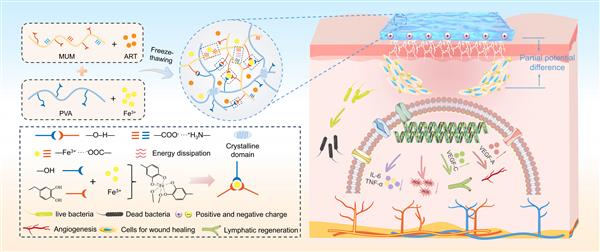Highly adhesive, stretch, antioxidative and antibacterial double-network hydrogel containing artemisinin for?infected wound?closure and healing
作者:Xinxiang Chai, Guohua Jiang *, et al.
关键字:hydrogel; wound healing; ROS-scavenging; double-network; biocompatibility
论文来源:期刊
具体来源:Chemical Engineering Journal
发表时间:2025年
Highly adhesive, stretch, antioxidative and antibacterial double-network hydrogel containing artemisinin for?infected wound?closure and healing
Xinxiang Chai a,b, Ruifei Ge a,b, Yanzhen Lou a,b, Turaqulov Fozil Mamaraim Ugli c, Khaydar E. Yunusov c, Lei Nie d, Muhammad Rafique Khan a,b, Guohua Jiang a,b,e,f*
Abstract: Infected wounds can trigger excessive oxidative stress and chronic inflammation, delaying wound healing, consequently placing a burden on human health and socioeconomics. In clinical applications, there is a lack of multifunctional wound dressings that combine antibacterial and antioxidant with good tension and adhesion properties. This study developed hydrogel dressings composed of polyvinyl alcohol (PVA)/mussel mucin (MUM)/ferric ion (PVA/MUM-Fe)/artemisinin (ART) (PVA/MUM-Fe/ART) by freeze-thawing method. The energy dissipation of PVA crystals and the double-network based on hydrogen and coordination bonds endow the hydrogel with high structural stability, strength and toughness. The hydrogel exhibited good tissue adhesion and ROS-scavenging properties due to the rich dopamine groups in the hydrogel. Furthermore, the hydrogel also exhibited good antibacterial, anti-inflammatory properties and high biocompatibility. In vivo results demonstrated that compared to commercial dressings, the resultant hydrogel dressing facilitated wound healing on an infected full-thickness skin defect by upregulating the growth factors such as VEGF-A and VEGF-C and downregulating that of inflammatory factor IL-6 and TNF-α. Transcriptomic results revealed that as-fabricated hydrogel dressing could promote the healing and regeneration of wound tissue by regulating inflammatory reaction, cell proliferation and migration, angiogenesis and matrix remodeling.
Keywords: hydrogel; wound healing; ROS-scavenging; double-network; biocompatibility
